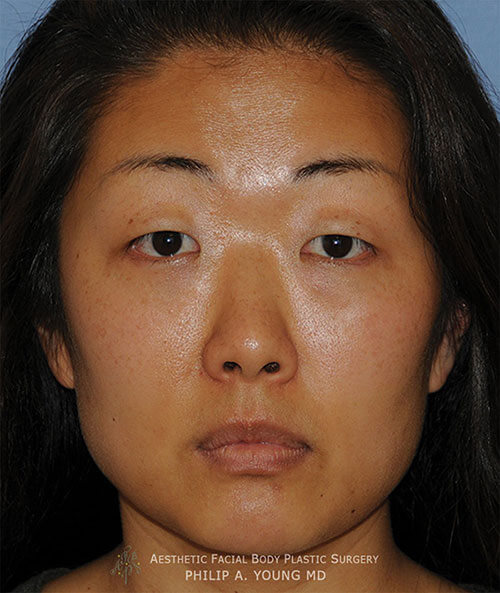Asian Blepharoplasty Orbicularis Levator Fixation Technique by Seattle Bellevue Dr. Philip Young
In the video above we are presenting a live video demonstration of our Orbicularis Levator Fixation Technique. In this video we will be discussing taking skin to increase the height of the crease, identifying the levator aponeurosis, cauterizing to make sure there is no significant bleeding, finding the areas to fix the levator to the orbicularis to create the crease, etc. This technique allow us to make the crease more permanent, more natural and more reliable. The crease with this technique is able to fold like a normal eyelid that has a double eyelid crease. The older, more traditional method of using sutures from the skin to the levator, or the dermal fixation method, always leaves a crease present even with the eyes closed. The Orbicularis Levator Fixation Technique avoids this better leaving a fold with a crease that is gone with the eyes closed and folds when the eyes open in a natural way.
“My goal was to find a method to bring back a person’s natural youthfulness without the operated, unnatural look and that is why I have my patients bring in photos of them when they were age 5 to 30. My YoungVitalizer helps restore natural and youthful contours they haven’t seen in years.”
—Dr. Philip Young, Seattle Facial Plastic Surgeon




We would like to discuss our technique of doing Asian Double Eyelid Surgery to create a crease for a person that has a single eyelid fold or a fold that is too low. On this page, we are going to discuss a unique approach, Orbicularis Levator Fixation Technique, that we use almost all the time to create the double eyelid crease. The procedure entails attaching the levator muscle to the muscle that closes the eye. This association then creates the fold. It allows the tissue of the eyelid below the incision and the proposed crease to slide under the skin above to form the crease. Traditionally, the double eyelid surgery is performed by attaching the skin to the levator with sutures that removed 7-14 days after the surgery. The scarring and adhesions that form from this is then the main way that the crease is created. This traditional approach often lead to variable results and folds | creases that had more chances for inconsistency. If you take a look at the picture below you might be better able to understand what we are talking about:

Asian Double Eyelid Orbicularis Fixation Technique Anatomy
As you can see from the picture above, traditional dermal fixation technique to create the asian double eyelid crease is to attach the skin (dermal) to the levator with sutures. These are removed at 7-14 days. Once removed the crease is held up by the adhesions from the scarring that is created. Everyone tends to form scars differently based on this your results can be variable. The orbicularis fixation technique attaches the orbicularis to the levator through sutures that are left in there permanently. Through this the sutures keep the crease more permanently as the sutures are left in there for good and are not taken out. This ensures that the crease will be more stable and last longer and be more consistent. You might be wondering why the sutures that attach to the orbicularis can lead to the crease being formed.
The answer is because the orbicularis is tightly adherent to the skin and acts like a single unit. The orbicularis fixation technique also leads to more natural results as the folds action is more natural and starts when the eye starts to open. With the traditional technique, the crease can have persistent indentations that are quite common. Meaning that, the crease has the potential to never really relax and stays a crease with the eyes closed. This can be a noticeable sign of a crease formation surgery. With the orbicularis fixation technique, the crease is gone when you close your eyes and forms when you open your eyes, like it does in nature in someone that has a fold | crease naturally.

Before Asian Double Eyelid Crease Formation Surgery

After Asian Double Eyelid Crease Formation Surgery
"I just wanted to say thank you again for your wonderful services. I was nervous about the procedure and I didn't need to be. You guys made me feel so comfortable and Dr young is amazing. I definitely chose the right surgeon. I'm healing very nicely. Swelling is going down. I had no bleeding or bruising. I will send pictures soon. " — - 30's Asian Female, Canada after her Asian Double Eyelid Procedure.


Before Asian Double Eyelid Crease Formation Surgery Right Oblique View

Before Asian Double Eyelid Crease Formation Surgery Right Oblique View Close Up

Before Asian Double Eyelid Crease Formation Surgery Left Oblique View

After Asian Double Eyelid Crease Formation Surgery Right Oblique View

After Asian Double Eyelid Crease Formation Surgery Right Oblique View Close Up

After Asian Double Eyelid Crease Formation Surgery Left Oblique View
